Downtown Murphy NC contains many interesting historic sites. These sites are designated by plaques located on or near the buildings and locations. Below is the list and descriptions of these sites.
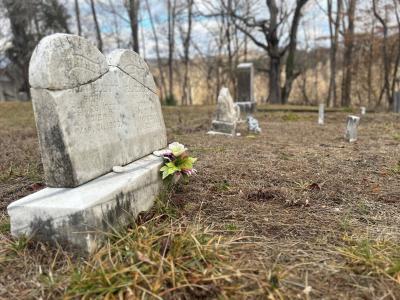
Baptist Cemetery
Location: 57 McClelland St, Murphy, NC
The Murphy First Baptist Church was chartered in 1845 and built its first church adjacent to this site in 1846. The original church was probably a log structure. This is the earliest cemetery for the Baptist pioneers in Murphy.
In 1927, the church built a beautiful Greek style building with huge white pillars, sculptured marble and stained glass on Peachtree Street, where the PNC Bank is now located.
This building served the church well for more than 50 years until the growth of the congregation made it apparent that another move was needed. In 1971, the church moved to its present location on Hiwassee Street.
Notice the new large headstone for David Taylor and his wife Mary Ann Bigby Taylor. Even though David Taylor was of European descent, his land was lost in the New Echota Treaty of 1835 because his wife was part Cherokee (about 3/8). The US government later paid him for this land in 1852. The couple also had six sons that fought in Thomas's Confederate Legion, a fearsome troop comprised of Cherokee men and men of European descent. This troop was also known as Thomas' Legion of Cherokee Indians and Highlanders. They were famous for their skill and persistence in tracking escapees and bushwhackers.
Listen to the audio file about this site here.
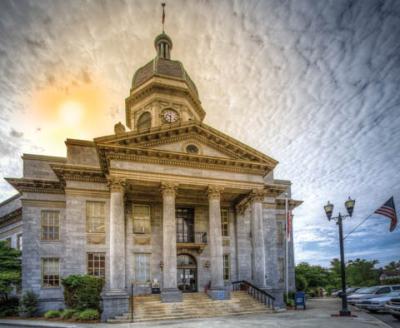
Cherokee County Courthouse
Location: 75 Peachtree St, Murphy, NC
Cherokee County was created by an act of the North Carolina legislature on January 4, 1839. At that time, the state stipulated that any of the buildings put up by the army at Fort Butler could serve as the courthouse and jail until a permanent courthouse could be built. So technically, the first county courthouse was in a vacant building at the army fort.
In 1840, a temporary log building was constructed on the corner of the public square in town and sufficed as the county courthouse until the county built its first permanent brick courthouse on the town square in 1844. The two-story brick building served the county until it was destroyed by the Union army after the end of the Civil War in 1865. The building was destroyed under the order of General Kirk of the Union army shortly after General Lee had surrendered. Apparently, the order to destroy was given prior to Kirk learning of Lee’s surrender.
Once again, the county government was back in a temporary courthouse until the burned-out building could be rebuilt. The new courthouse was rebuilt on the original site on the public square in 1868 and served the county until 1892 when a new, larger courthouse was built here on the site of our current courthouse.
We seem to have bad luck with courthouses, because the one built in 1892 was destroyed by fire in 1895. It was rebuilt in 1896, but burned again in January, 1926.
So, if you count all the courthouses, both permanent and temporary since Cherokee County was formed, the courthouse you see now is our 8th courthouse.
The current Cherokee County Courthouse was built in 1927, and cost $256,000 to build. The courthouse is constructed of Blue Marble that was quarried locally in the Marble community of Cherokee County. The Cherokee County Courthouse was placed on the National Register of Historic Places in 1979.
At one time the view of this building was quite impressive. Unfortunately, the site integrity was badly affected when taller buildings were added to Peachtree Street adjacent to the courthouse which now obscure the building from the public square. (source: Pine and Log)
Listen to the audio file about this site here.
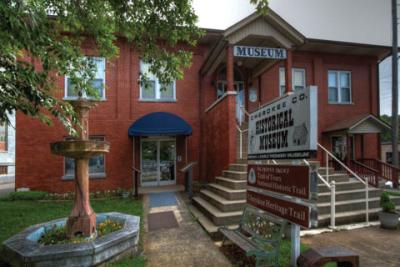
Cherokee County Historical Museum
Location: 87 Peachtree St, Murphy, NC
Did you know that this building was once a library? Even more interesting is that the library was built with money that was given to the town by the Scottish-American philanthropist, Andrew Carnegie.
The Town of Murphy received a grant of $7,500 on May 15, 1916 which paid for a good portion of the construction cost of the library at that time. This was one of ten libraries built in North Carolina with Carnegie grants. Throughout the country, Carnegie help build nearly 1,700 libraries by the time the last library grants were awarded in 1919.
Even as a child, Carnegie had a passion for books and libraries. His personal experience as an immigrant and laborer that was given access to books by his employer helped form this passion.
With hard work and help from others, he worked his way into a position of wealth, reinforcing his belief in a society based on merit, where anyone who worked hard could become successful. This conviction was a major element of his philosophy of giving, and grants for libraries like this one in Murphy are its best-known expression. This building housed the Murphy Library for 60 years until it moved from this location to the new building located just down the hill during the summer of 1976.
The Cherokee County Historical Museum is now housed in this old library building. The collections in the museum include an extensive display of Cherokee artifacts, a mineral display, a doll collection and area genealogy and artifacts from early settlers. Arthur Palmer's collection of over 2000 items found its way here in 1977. He was a lifetime collector of artifacts, some of which were excavated from local Cherokee burial mounds. Other artifacts were purchased or bartered from area citizens.
The museum also houses an interpretive display that interprets the life of the Cherokee people in this area before their removal along the "Trail of Tears" to Oklahoma.
(Source: A Pictorial History of Cherokee County 1995.)
Listen to the audio file about this site here.
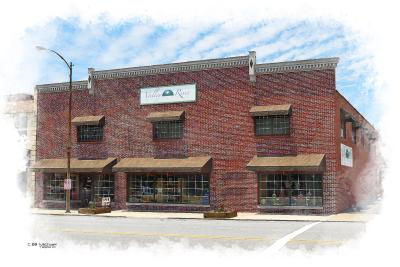
EC Moore Building
Location: 33 Valley River Ave., Murphy, NC
For more than 50 years this building was the Dodge-Plymouth car dealership. It was built and owned by Edward Covington Moore, also known as “E.C.”. He came to Murphy in 1910 (from Hayesville) and went into the jewelry business with his brother. The jewelry store was next door to the right, where the Hicks Service Station is now.
In 1918, only two families in Murphy had an automobile. The main reason was the condition of the roads - which were so bad that an automobile was not practical. However, by 1919 the roads had improved enough that E.C. decided to buy an auto dealership for a brand called “Willys-Overland Motors” based out of Toledo, OH. At that time Willys was the second largest producer of automobiles in the United States after Ford Motor Company. That year E. C. received one car. However, the 1920 recession brought the Willys Corporation to its knees. By 1922, E. C. applied for the Dodge dealership. Business was good and sales were brisk. The auto business continued to prosper while he lived.
Mr. Moore served on the town council and on the county commissioners board, where he was the chairman. At one time the county was in a serious financial crisis, and Mr. Moore took out a loan under his own name in order to bridge the crisis.
Mr. Moore also donated the land for the Free Methodist Church on Valley River Avenue. In 1940, across the street from the church, where the post office now stands, Mr. Moore built the first motel in Murphy, which he called “Mooreland Heights Tourist Court”.
At the time of E.C.’s death in 1963, his auto dealership was the oldest business in Murphy. The dealership then passed to E.C. Moore’s sons Cloe and Rae Moore. Cloe Moore served for many years as the Mayor of Murphy, starting in 1966.
Sources: Pictorial History of Cherokee County, 1995 and Freel’s History Book 1950. Family history submitted by Moselle Moore Puett. A 1961 Cherokee Scout article.
Listen to the audio file about this site here.
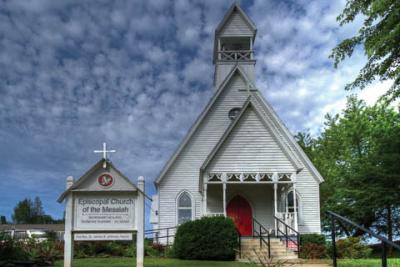
Episcopal Church of the Messiah
Location: 76 Peachtree St., Murphy, NC
Episcopal missionaries reached Murphy in 1853. By 1860 a one-fourth acre of land had been purchased. The current Carpenter Gothic sanctuary was completed in 1896. The William Beal family was instrumental in the construction of this church. By 1902 the church was consecrated a mission and named Church of the Messiah.
The features of the exterior that research suggests are original are the building's frame, bell tower, porch and sacristy. Those of the interior that are likely original are the altar, bell, floor, and the incredible herringbone paneling made of heart-of-Georgia pine.
Listen to the audio file about this site here.
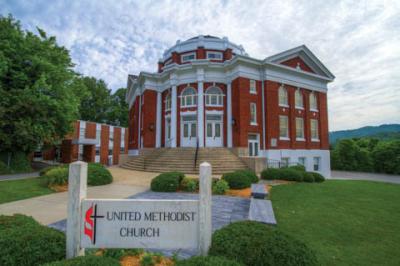
First United Methodist Church of Murphy
Location: 73 Valley River Ave., Murphy, NC
The brick Methodist church building in front of you was built in 1922. The domed Neoclassical Revival form is typical of many Methodist churches of the early 1920s. As grand as the exterior is, the interior is even grander. Every Sunday morning, as the sun rises, it illuminates 41 opalescent stained-glass windows. An overflowing radiance pours over the sanctuary and the worshipers filling the pews. Many of the stained-glass windows bear dedication plaques to the early town citizens of the time, with last names such as Harshaw, Fain, Dickey, Griffiths, Henry, and Hughes.
The congregation originally met in the Harshaw Chapel, located at 150 Church Street around the corner. When the congregation outgrew that space, plans were set in place to build this structure – a major landmark in the town.
Listen to the audio file about this site here.
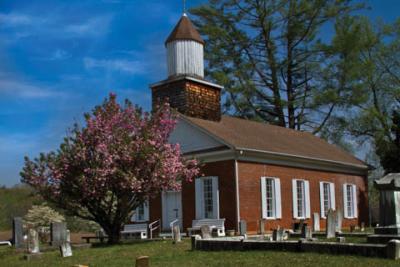
Harshaw Chapel
Location: 150 S. Church St., Murphy, NC
The Harshaw Chapel stands today as Murphy's oldest intact structure and the county's oldest remaining church building.
Records indicate that construction of the simple Greek revival church began in 1857 when the first corner stone was set. It was completed around 1869 when it was dedicated to the Methodist Episcopal Church South by Joshua Harshaw. Note the inscription above the door.
Nine years seems like a long time to build a building like this, but you must remember that construction may have been interrupted by the Civil War (1861-1865).
Prior to this brick building, the church had a wood building on this lot, which was lit with tallow candles. Methodists have been worshipping on this land since 1842.
This Chapel served the First Methodist congregation for more than 50 years. As the congregation grew, the need for a larger church became apparent.
In 1922, the construction of the present-day home for the church began. The beautiful new 2-story neo-classical church on Valley River Avenue was dedicated in 1929 and this old chapel fell into disuse.
In the 1940's another Methodist congregation, the Free Methodists, leased the chapel for a while until their own building was constructed.
Other than this short revival, the building has remained largely unused for nearly a century.
In 1965 the deteriorating building was deeded over to the Archibald D Murphy Chapter of the Daughters of the American Revolution in hopes that it would be restored and maintained. Some restoration work was done, but the building was largely neglected.
In 2013, the building ownership was returned to the First United Methodist Church. Efforts are currently underway to fund the extensive restorations needed to preserve this treasured piece of our history.
The chapel is included on the National Register of Historic Places which is the United States federal government's official list of districts, sites, buildings, structures and objects deemed worthy of preservation for their historical significance.
Listen to the audio file about this site here.
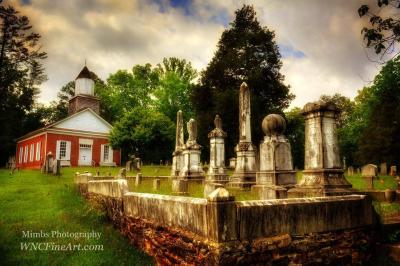
Harshaw Chapel Cemetary
Location: 150 S. Church St., Murphy, NC
Cemeteries can tell the history of an area and often these stories are filled with mystery, legend and lore. The cemetery here at the Harshaw Chapel is no exception.
This cemetery is as old as Murphy itself. The names inscribed on the gravestones represent the families and individuals of Murphy's earliest pioneers.
The oldest grave here, that of Nancy Crump Hayes, dates back to 1840. The nearby town of Hayesville was named after her husband, confederate Captain George Washington Hayes.
The graves with the initials C.S.A indicate the Civil War era graves of Confederate Soldiers. On the far side of the graveyard, near the tree-line are the simple grave markers of former slaves.
With so much history represented here, stores and legends abound.
Of particular interest is the grave of Abram Enloe. According to local legend, he was the biological father of America's 16th President, Abraham Lincoln.
This story runs contrary to the official versions of Lincoln's parentage, but there is considerable evidence supporting the claim that Lincoln's father was, in fact, Abram Enloe.
As the story goes, Lincoln's mother, Nancy Hanks, was a young unmarried woman in the employ of Enloe as a household servant somewhere around the time between 1801 and 1806, when she became pregnant. For Enloe, a prominent citizen of the area, this was potentially scandalous.
To get out of the predicament, Enloe sent the young woman away to Bostic, NC, where she gave birth to a boy who she named Abraham.
The legend goes on to say that, Enloe used his political connections and a $500 payment to arrange Nancy Hank's marriage to Tom Lincoln in Hodgenville, Kentucky, effectively solving the problem for Enloe.
And now, for the young lad named Abraham Lincoln, the rest is history.
Take some time to walk through the cemetery and explore our history. Please be respectful and do not disturb the graves of the families resting here.
Listen to the audio file about this site here.
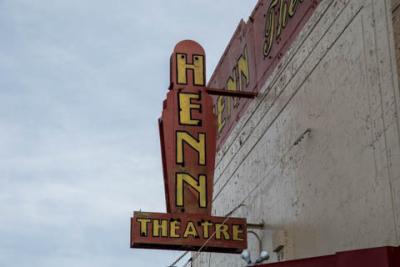
Henn Theater
Location: 38 Tennessee St., Murphy, NC
Preston Jefferson "P.J." Henn, opened the Henn Theater in 1934 and it has been family owned until very recently. Of the 23 theaters owned or operated P.J. Henn, only two survived the Great Depression and only this one in Murphy survives today. Originally, Murphy's Henn Theater was located just around the corner from here but moved to this current location in 1941.
In the years before television, theaters like this were the cultural centers of the cities. Connecting Murphy to the world through cinema for entertainment and bringing the world to our doorsteps with newsreels, theaters were an important part of the daily lives in our little town. In fact, at one time, Murphy had two movie theaters and an opera house! Imagine the activity in town on a typical Saturday night!
Times change and now television, streaming video and the internet have changed how we are entertained and informed, and most old theaters like the Henn have struggled and closed their doors.
On March 16, 2009, the Henn Theatre was damaged by a fire. The main auditorium and front of house sustained only smoke damage, but the stage and back stage areas were considerably damaged, putting the movie theater out of use for a while. It reopened in May 2009.
In 2017, the Henn was purchased by new owners and they have worked hard to preserve the historic nature of the theater while upgrading it to modern times. The projection and sound systems were upgraded so that high quality, first run movies could be shown. The new owners have preserved much of the original interior and experiencing a movie in this historic gem is indeed a joy you must experience. Come inside the lobby and enjoy the display of movie memorabilia, then order some popcorn at the historic snack counter before finding your seat in the comfortable theater. You will feel like you have stepped back into a time when "Talkies" were new and color films were only a dream.
Listen to the audio file about this site here.
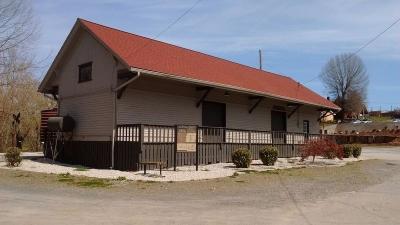
L&N Depot
Location: 4 Railroad St., Murphy, NC
Standing here at the L&N Depot, you see what little is left of a small railroad with a long history.
This small freight depot with an old boxcar and caboose on this section of track are all that is left of a railroad who’s history began in the mid 1800’s.
The idea building a railroad from Atlanta north through to North Carolina was conceived around 1850. Delayed by the Civil War, the construction began in 1874 finally making it from Atlanta to Murphy in 1891.
About that same time, the rail from the East arrived connecting Murphy to Asheville and beyond.
Connecting the two rails in Murphy would take a bit longer. Because of a legal dispute over the right-of-way ownership crosing the Hiwassee River, the connecting bridge wasn’t built until 10 years later in 1901.
For nearly half a century, the trains rolled through town.
But, improvements in the local highway system and the convenience of modern cars and trucks would soon take the profit out of the rail system. Passenger rail service through the area ended in 1948. Freight service continued for a while longer, but in the late 1980’s, when the local textile industries moved out of the area to overseas manufacturing plants, freight service also ended.
With no active rail service to the area, the track from Murphy south to Mineral Bluff was removed. The bridge over the Hiwassee dismantled.
In 1985, the North Carolina Department of Transportation purchased the remaining track from Murphy to Dillsboro, NC. Much of that rail is currently leased to the Great Smoky Mountain Rail Road for tourist train excursions, but even those trains no longer travel this far west. The last train from Murphy departed this station on July 4, 1992.
There is hope that someday, the trains will return. Perhaps one of the great steam engines will return and recreate the glories of the railroad era for us to enjoy again!
For more information on the railroad history in Murphy, stop into the Cherokee County Historical Museum, located in Downtown Murphy.
Listen to the audio file about this site here.
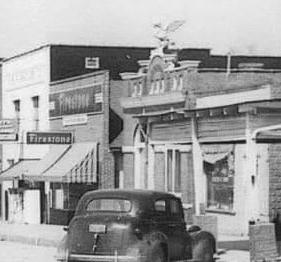
Murphy's First Bank
Location: 33 Peachtree St., Murphy, NC
Welcome to the site of Murphy's first bank. Notice the worn marble steps at the entrance. Imagine how many people it took going in and out of this building to wear them down to this extent! The Miner's and Planter's Bank was chartered in 1859 by Colonel Allen Davidson, a lawyer who moved to Murphy in 1846.
At that time, the bank was authorized by federal government and the state of North Carolina to print and issue currency just for Cherokee county. In the pre-civil war era, state chartered banks were essential to county and city economies, so these locally issued notes became an important part of the growth of our economy.
The bank notes issued in 1861 by the Miner's and Planter's Bank were printed in New York and each note was personally signed by the bank president and its head cashier.
The Civil War began on April 12, 1861 and the newly formed Confederate States of America began to issue its own printed currency, soon replacing the state and locally issued notes.
As the war dragged on, the Confederate notes began losing their value and when the war finally ended in 1865, the money became virtually worthless and all the state banks failed.
The U.S. Government also was issuing its own national currency at that time and a law enacted in 1865 placing a 10% tax on all non-government notes drove all local and state currencies out of existence.
Ironically, the once worthless bank notes issued by the Miner's and Planter's Bank of Murphy have become quite valuable to collectors, often demanding 10 to 20 times the face value or more!
The National Museum of American History has one of the bank notes in their collection in Washington, DC.
Listen to the audio file about this site here.
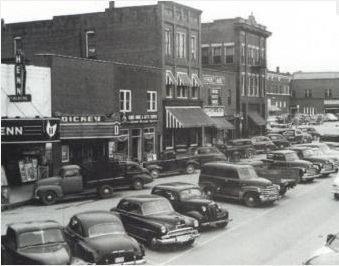
Opera House/Old Dickey Theater
Location: 36 Tennessee St., Murphy, NC
This 1898 building was once the site of Bates’ Opera House. The lobby had an impressive 30-foot ceiling. Over time, movies became more popular than opera, and by the 1940s this building became the Dickey Movie Theatre. The original coal burning furnace is still in the back of the building along with the coal slot. Tickets cost either ten cents or twenty cents back in the 40s. All service men were admitted free any time.
Later the building was converted into retail space and the sloping ceiling and floors were made level. Sections of the original stage floor and backstage areas are still visible in the rear sections of the building.
Sources: Firsthand account from owners along with newspaper clipping dated Sep. 2 1943.
Listen to the audio file about this site here.
